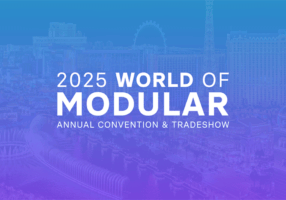Part I: Valuing Levels of Innovation
Valuing Levels of Innovation in the Modular Construction Industry

Heather Wallace is the Director of Communications and Project Manager at the Momentum Innovations Group.
What Exactly is Innovation?
One of the best ways to determine whether or not something is innovative is if it creates new value. Innovation is when a product, service, or knowledge is renewed, modernized, or improved by the application of new processes, the introduction of new techniques, or establishing successful ideas…to create new value in the market. And there are multiple levels of innovation.
Incremental innovation creates feature improvements on an existing product or service. It requires continuous improvement - something that must be built into the culture of a company where employees at all levels feel empowered and equipped to explore and share new ideas.
Site-built stick framing has been incrementally improving over many decades - from timber framing to platform framing - including an improvement of tools and some materials - from plywood to OSB to MDF and fire-rated wood. But images of framing from 100 years ago look eerily similar to images of framing today.

Adjacent innovation utilizes existing knowledge with the application of technology to gain new audiences.
The Modular Mobilization Coalition is a good example of adjacent innovation. When Covid-19 patients began filling-up healthcare facilities around the country, sixteen independent modular companies banded together to help solve this challenge. All of the companies had an existing knowledge of modular construction - they were all building somewhat similar products for the residential, commercial, and educational spaces. The adjacent innovation happened when all of these companies agreed to manufacture a standardized healthcare product based on a modular platform that allowed the emergency healthcare product to be moved and then converted to permanent residential units when the emergency ended.
Although MMC never got to fully deploy their standardized and configurable modular platform, the concept spawned a number of new initiatives.
Disruptive innovation is the most exciting type of innovation. It shakes up an industry and has the potential to take over market share of existing business from larger, legacy companies. Many times this type of innovation is fueled by the desire to solve a nagging specific industry challenge.
Back in 2007 the founders of Airbnb, Brian Chesky and Joe Gebbia, were living in San Francisco with no money and rented out air mattresses in their apartment to conference attendees because they could not find a hotel. A study from the National Bureau of Economic Research found that in 10 US cities with the largest Airbnb market share, “the entry of Airbnb resulted in 1.3 percent fewer hotel nights booked and a 1.5 percent loss in hotel revenue”. Airbnb not only disrupted the hospitality sector, but the travel sector, as well. They democratized the travel industry - creating more affordable or diverse options for everyone.
3D printing buildings in the construction industry has the potential to be both an adjacent and disruptive innovation. Companies like Mighty Buildings and ICON are utilizing an existing building material - concrete - albeit in a slightly different format, and combining it with a technology already being successfully used in other industries. Creating buildings using 3D printing technology still has a ways to go but does have the potential to offer end users an alternative building method and take business from traditional site built construction.
Why is There So Much Failure?
Only a small amount of innovative ideas actually become successful in the marketplace. Why is it so difficult for companies to innovate successfully?
First and foremost, most legacy companies actively resist innovation, this is especially true in the fragmented construction industry. This is a major challenge as there are hundreds of thousands of independent trades, builders, distributors, and building material companies who work hard but generally maintain the status quo. It’s often said people are scared of change, but a more nuanced perspective is they fear loss, whether it is profits, time or familiarity.
Secondly, early traction and scaling is important but this is very difficult in our industry, exacerbated by combative contracts, little transparency and low-bid transactional relationships. Innovating one part of the process or within a particular geographical area often does not result in another area of the industry moving any faster.
One of the most famous disruptive innovators in the construction industry was Katerra. Whatever your viewpoint of Katerra was, their goals of mass manufacturing + technology positioned them to create efficiencies rarely seen in the construction industry. Their problems were rooted in unrealistic growth and forgetting they were a manufacturing company. Although their failure was highly public and predicted by many, it does not change the fact that they had the potential to be disruptive.
It is unfortunate that hard-tech construction innovation requires a 10+ year commercialization timeline but this means that patient capital is essential for success.
Ultimately, meaningful innovation creates new value whether it’s through incremental, adjacent or disruptive innovation. And we can (hopefully) all agree we need more!
Stay tuned for Part II of this series in a future issue of Modular Advantage as we dive deeper into the topic of innovation.
More from Modular Advantage
AI, Faster Sets, and Automation: The Future of Modular is at World of Modular
While the modular building industry has long known that it can be an effective solution to increase affordable housing, the word is slowly spreading to more mainstream audiences. Three presentations at this year’s World of Modular in Las Vegas hope to provide insight and direction for those seeking a real solution to the crisis.
An Insider’s Guide to the 2025 World of Modular
The Modular Building Institute is bringing its global World of Modular (WOM) event back to Las Vegas, and with it comes some of the industry’s best opportunities for networking, business development, and education. Over the course of the conference’s four days, there will be numerous opportunities for attendees to connect, learn, and leverage event resources to get the most out of the conference.
Affordable Housing Now: The Industry’s Best Bring New Solutions to World of Modular
While the modular building industry has long known that it can be an effective solution to increase affordable housing, the word is slowly spreading to more mainstream audiences. Three presentations at this year’s World of Modular in Las Vegas hope to provide insight and direction for those seeking a real solution to the crisis.
Opportunities for Innovation in Modular Offsite Construction
Modular Offsite Construction has already shattered the myth that it only produces uninspired, box-like designs. Architectural innovations in module geometry, configurations, materials, and products make it possible to create visually stunning buildings without sacrificing functionality or efficiency.
Safe Modular Construction with Aerofilm Air Caster Transport
In collaboration with Aerofilm Systems, Heijmans developed innovative skids using air caster technology for moving modules easily and safely. These pallets are equipped with an auto-flow system, making operation extremely simple.
Miles, Modules, and Memes: Building a Modular Network One Flight at a Time
At the end of the day, social media is just another tool for building connections, and like any other tool, needs to be used skillfully to work properly. Use social media thoughtfully, and it will open doors to real opportunities and relationships you didn’t even see coming.
Falcon Structures: Thinking Inside the Box
Some of Falcon’s latest projects include creating container solutions for New York’s Central Park and an East Coast professional baseball team. More and more, Falcon is shipping out container bathrooms and locker rooms to improve traditionally difficult work environments, like those in oil and gas or construction.
UrbanBloc—From Passion to Industry Leader
UrbanBloc specializes in three main categories or markets – what they call “Phase 0” projects, amenities, and urban infill. Clients are often attracted to shipping containers because from a real estate perspective they are considered an asset. Having the flexibility to move and transport these assets allows owners to respond to different circumstances in a fluid manner that they can’t get with standard construction.
The Hospitality Game-Changer
“Hospitality is about more than just providing a service – it’s about delivering an experience,” says Anthony Halsch, CEO of ROXBOX. “And that’s where containers thrive. They allow us to create spaces that are unique, efficient, and sustainable.”
Container Conversions Counts on Simplicity to Provide Critical Solutions
Container Conversions has fabricated and developed thousands of containers for varied projects, including rental refrigeration options, offices, kitchens, temporary workplace housing, and mobile health clinics.










